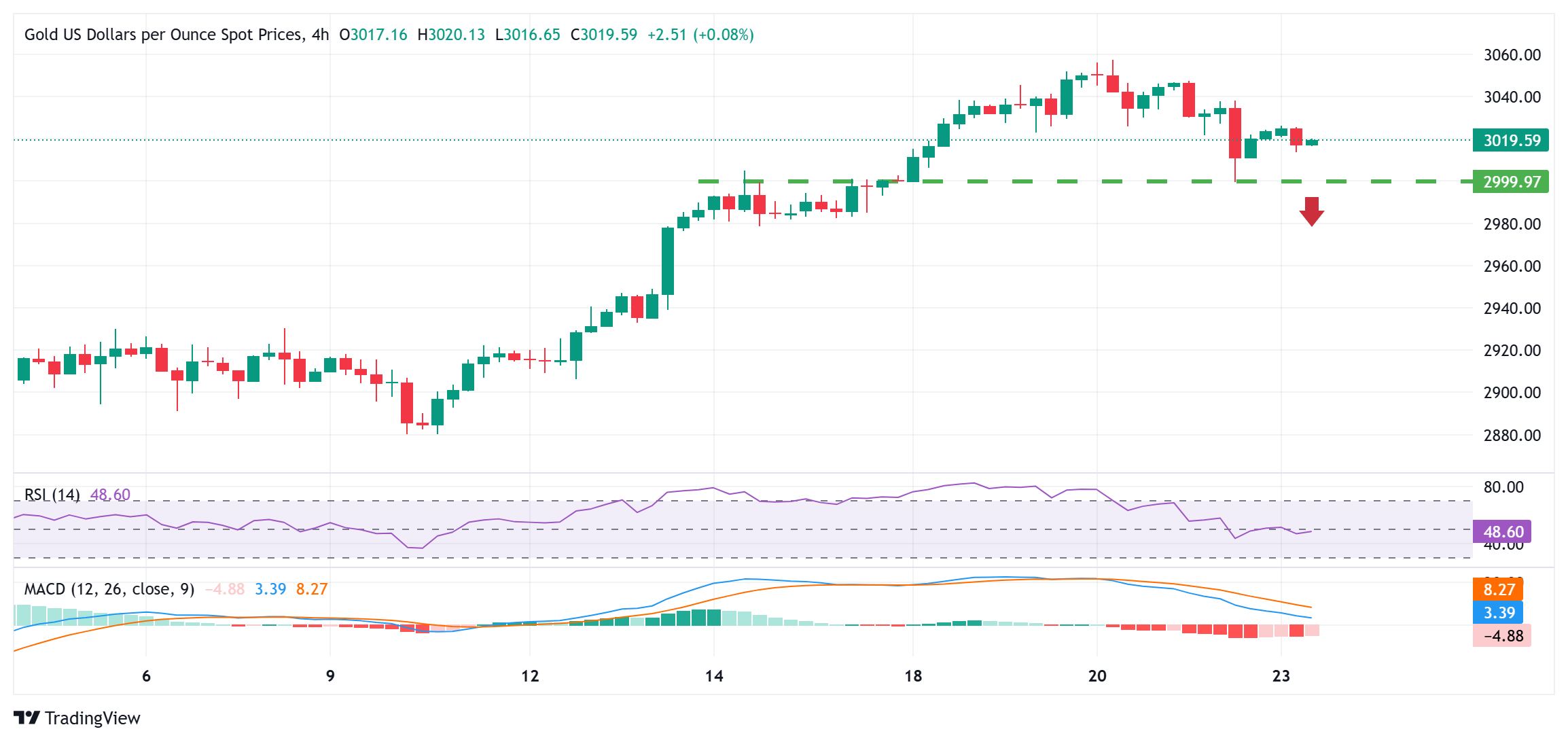- Gold price attracts some dip-buyers and snaps a two-day losing streak.
- Fed rate cut bets weigh on the USD and underpin the XAU/USD pair.
- A positive risk tone and a pickup in the US bond yields might cap gains.
Gold price (XAU/USD) edges higher during the first half of the European session and looks to build on Friday’s late rebound from the $3,000 psychological mark. The US Dollar (USD) kicks off the new week on a weaker note and stalls a three-day-old recovery move from a multi-month low amid bets that the Federal Reserve (Fed) will resume its rate-cutting cycle soon. This, in turn, is seen as a key factor acting as a tailwind for the non-yielding yellow metal.
Meanwhile, global risk sentiment gets a minor lift in reaction to reports that US President Donald Trump’s reciprocal tariffs would be narrower and less strict than initially feared. This, along with a goodish pickup in the US Treasury bond yields, might hold back traders from placing aggressive bullish bets around the Gold price. Traders now look to the release of flash US PMIs and speeches from influential FOMC members for short-term opportunities.
Daily Digest Market Movers: Gold price draws support from renewed USD selling bias
- Reports over the weekend indicated that US President Donald Trump is planning a narrower, more targeted agenda for the so-called reciprocal tariffs set to take effect on April 2. This, in turn, boosts investors’ appetite for riskier assets and undermines the safe-haven Gold price at the start of a new week.
- Delegations from the US have been holding talks with Ukrainian officials as part of peace negotiations and will meet Russian officials on Monday for further talks. Trump and Russian President Vladimir Putin earlier this month agreed on a 30-day pause on Russian strikes on Ukrainian energy facilities.
- The US Dollar held steady near a one-and-half-week high touched on Friday in the wake of the Federal Reserve’s less dovish outlook, maintaining its forecast to deliver two 25 basis points rate cuts by the end of this year. This turns out to be another factor weighing on the non-yielding yellow metal.
- Meanwhile, Fed Chair Jerome Powell said last week that tariffs are likely to dampen economic growth. Moreover, traders still see the US central bank lowering borrowing costs at the June, July, and October monetary policy meetings, which keeps a lid on the USD and could support the XAU/USD pair.
- Israel continues with its heavy strikes in Gaza and bombs the largest hospital in the southern region, killing Hamas leader Ismail Barhoum. Meanwhile, Iran-backed Houthis in Yemen fired a ballistic missile at Israel on Sunday, though it was successfully intercepted by Israel’s air defense.
- Furthermore, the US military conducted fresh airstrikes on Yemen’s northern province of Saada. Moreover, Houthis claimed to have launched fresh attacks on an aircraft carrier in the Red Sea and the Ben Gurion airport in central Israel, raising the risk of a further escalation of Middle East tensions.
- Traders on Monday will look to the release of flash global PMIs, which would provide fresh insight into the global economic health and provide some impetus to the commodity. The focus, however, will remain on the US Personal Consumption and Expenditure (PCE) Price Index on Friday.
Gold price seems poised to appreciate further while above the $3,000 pivotal support
From a technical perspective, any subsequent slide might continue to attract some buyers near the $3,000 mark. The said handle should act as a key pivotal point, which if broken decisively might prompt some technical selling and drag the Gold price to the $2,982-2,978 region. The corrective fall could extend further towards the $2,956-2,954 resistance breakpoint, now turned support.
On the flip side, the all-time peak, around the $3,057-3,058 zone touched last week, could act as an immediate hurdle. Given that the daily Relative Strength Index (RSI) has trended lower from the overbought territory, some follow-through buying will be seen as a fresh trigger for bulls. This, in turn, will set the stage for an extension of the recent well-established uptrend witnessed over the past three months or so.
US Dollar PRICE Today
The table below shows the percentage change of US Dollar (USD) against listed major currencies today. US Dollar was the strongest against the Japanese Yen.
| USD | EUR | GBP | JPY | CAD | AUD | NZD | CHF | |
|---|---|---|---|---|---|---|---|---|
| USD | -0.25% | -0.30% | 0.16% | -0.15% | -0.38% | -0.05% | -0.10% | |
| EUR | 0.25% | -0.15% | -0.10% | 0.14% | -0.15% | 0.24% | 0.19% | |
| GBP | 0.30% | 0.15% | 0.47% | -0.34% | -0.02% | 0.40% | 0.23% | |
| JPY | -0.16% | 0.10% | -0.47% | -0.32% | -0.57% | -0.20% | -0.28% | |
| CAD | 0.15% | -0.14% | 0.34% | 0.32% | -0.18% | 0.10% | 0.05% | |
| AUD | 0.38% | 0.15% | 0.02% | 0.57% | 0.18% | 0.40% | 0.34% | |
| NZD | 0.05% | -0.24% | -0.40% | 0.20% | -0.10% | -0.40% | 0.00% | |
| CHF | 0.10% | -0.19% | -0.23% | 0.28% | -0.05% | -0.34% | -0.01% |
The heat map shows percentage changes of major currencies against each other. The base currency is picked from the left column, while the quote currency is picked from the top row. For example, if you pick the US Dollar from the left column and move along the horizontal line to the Japanese Yen, the percentage change displayed in the box will represent USD (base)/JPY (quote).








